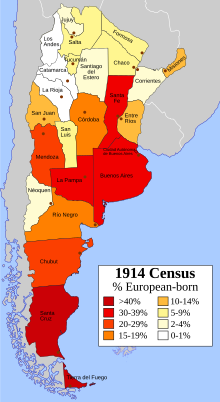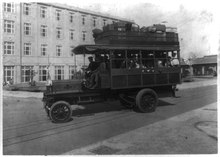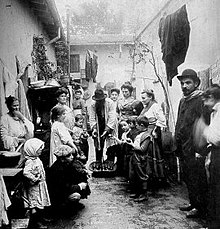You can help expand this article with text translated from
the corresponding article in Spanish. (July 2019) Click [show] for important translation instructions.
|


The Great European Immigration Wave to Argentina was a major source of economic growth and social change for Argentina. Beginning in the late 19th century, the wave consisted largely of Italian and Spanish immigrants, [1] though it did include other nationalities and ethnic groups, most notably a large Slavic and Jewish population. The rapid influx of European migrants led to immense population growth in Argentina, and the migrants were incredibly influential in the politics of the nation by introducing political concepts like labor unions and socialism into the country's political zeitgeist. [2] The remnants of the Immigration Wave of migrants are still visible in Argentina today, not only as a result of their influence on the country's economic and political history, but as cultural cornerstones in both urban and rural communities alike. Shifting labor markets and decreased reliance on European economics after the outbreak of World War I had a huge effect on European Migration to Argentina. These factors all lead to the end of the Great European Immigration Wave and began an era of Latin American politics primarily focused on domestic growth rather than the outsourcing of international labor. [3]
Causes
In Argentina, the economic demand for immigration, political support, and racial ideology of elites created strong conditions for a wave of Europeans to enter the country.

Immigration policies
From the 1850s into the early 1900s, Argentina's national policy was one of maximizing immigration. [1] The Constitution of Argentina of 1853 promoted European immigration in its 25th article, which prohibited any barriers on immigration. [4] Only the "insane" and those with communicable diseases were not allowed. [1]
The Immigration and Colonization Act of 1876 further encouraged immigration by subsidizing lodging and transportation, and providing job placement support. [5] This law came at the forefront of the Great European Immigration Wave, and informed part of why Argentina became a mass destination for immigrants.
Economic incentives
In comparison to many other Latin American countries at that time, Argentina offered higher wage opportunities for immigrants. [6] These wages were also significantly higher than those available in some of the main source countries like Italy, Spain, and Portugal. [6] Argentina possessed an untapped wealth of natural resources that created high demand for both skilled and unskilled labor. [6]
Racial motives

One salient motive for the promotion of European immigration was the belief that a large European population was needed to "modernize" the country. [7] Argentine intellectuals, such as Juan Bautista Alberdi, believed that population growth and population demographics were equally important to modernization. [1] Argentine elites associated the mestizo population with "backwardness" and as a hindrance to national progress. [1] Whiteness, however, was associated with civility and progress, making an all-white population the ideal. [8] By encouraging European immigration, Argentine elitists and intellectuals saw an opportunity to "whiten" the population and benefit from European technological innovations. [1] [7]
Impact of European immigration
Demographic

As a result of the immigration wave, Argentina's population was roughly four times larger in 1914 than it was in 1870. Roughly 6.6 million Europeans immigrated to Argentina within this timeframe. [11] While immigrants came from all over Europe, the three most represented countries of origin were Italy, Spain, and France. [5] Collectively, immigrants from these three countries accounted for over 5 million immigrants. [5] While the population increased, Argentine citizenship did not. Legal citizens made up 2.2% of the entire immigrant population by 1914. [11] However, Argentina's Citizenship Law gave citizenship to all persons born in Argentina. [12] The immigrants themselves did not become citizens, but their children did, which would create a new middle class. [12]
Origin of immigrants up to 1940
| Gross immigration by nationality (1857–1940) | ||
|---|---|---|
| Nationality | Amount | Percentage of total |
| 2,970,000 | 44.9% | |
| 2,080,000 | 31.5% | |
| 239 000 | 3.6% | |
| 180 000 | 2.7% | |
|
|
177 000 | 2.7% |
|
|
174 000 | 2.6% |
| 152 000 | 2.3% | |
|
|
111 000 | 1.7% |
| 75 000 | 1.1% | |
| 65 000 | 1.0% | |
|
|
48 000 | 0.7% |
| 44,000 | 0.7% | |
| 26 000 | 0.4% | |
| 18 000 | 0.3% | |
| 12 000 | 0.2% | |
| 10,000 | 0.2% | |
| 7000 | 0.1% | |
| Other nationalities | 223 000 | 3.4% |
| Total [Note 7] | 6 611 000 | |
Source: National Directorate of Migrations (DNM).
Economic
Economically, Argentina benefited from European immigration. During the wave of European immigration, Argentina’s percentage of world GDP grew from .99% to 2.42% as a result of immigrant labor. [13] Immigration helped connect Argentina to the global economy, as a 10% increase in immigrants from a particular origin country was roughly equal to an 8% increase in exports to that country. [13] With the influx of laborers, Argentina was able to expand its agricultural production and exportation. [7] The agricultural sector was equipped to handle the increase in laborers, as many rural property owners had uncultivated farm land. [7] By renting their land to immigrants, many rural towns were able to flourish with the cultivation of large land worked by European immigrant families. [7]
Beyond production, immigrants also aided Argentina's industrialization efforts. 70% of immigrants lived in urban areas in 1914, which was a ten percent increase over a twenty year period. [8] The increase in production additionally created a need for increased transportation networks. [1] To build these networks, Argentina again sought and supported immigrant labor. [1] In 1905, Argentine railroad companies sponsored the immigration of more than 20,000 Italians. [11]
Social
The population of Argentina grew four-fold over the Great European Immigration Wave causing a change to the social structure of Argentina. [14] The Constitution of 1853 explicitly encouraged European immigrants as a tool to civilize and whiten the Argentine population. [14] The elites (the descendants of the Spanish colonial ruling class, along with a small group of wealthy European immigrants) believed that the Native peoples of Argentina were savages and that European immigrants "could industrialize the primitive country of Argentina." [7] This belief created a rigid hierarchical social structure defined by racial classifications, where Europeans were seen as superior to the Native and Black populations. [1] The early waves of immigration did not have an accepting culture for non-European people and displayed this through the mass killing of the Native and Black populations. In the War of the Triple Alliance (where Paraguay fought to preserve its sovereignty from Argentina, Brazil, and Uruguay from 1864 to 1870), the population of Native and Black people declined in Argentina because they were killed in the war. [14]
The new middle class emerged from this influx of European immigrants. [7] The European immigrants provided labor to the untapped Argentine land. In addition to developing agricultural production these immigrants caused an increase in middle-class development. [7] Prior to the 1870s, Argentina exhibited a three-tiered class structure consisting of an elite, a ruling class, and a peasant class. Between 1870 and 1914, the once small middle class grew by 30%. [7] 46% of this emerging socio-economic group were European-born immigrants, according to a 1914 census. [15]
The higher pay in Argentina compared to Europe for manual labor attracted many immigrants causing crowded cities and higher crime. [1] Between 1887 and 1912 Buenos Aires's population tripled while the number of crimes reported increased seven times. [6] In Buenos Aires, it was estimated that an average immigrant family contained five people in a one-room house that was twelve by twelve feet. [1] The crowded cities were also a central point in crime. There was a rapid increase in thieves, pickpockets, racketeers, and prostitution making large cities like Buenos Aires infamous by 1914. [1] Argentina's unemployment also rose, further increasing poverty rates. It is estimated that 73% of the inmates in the Buenos Aires beggars' asylum were foreigners. [6]
Cultural
The mass amount of immigration in Argentina created a melting pot for many different cultures. The mix of European and Native cultures led to a new mestizo culture and a "formation of an identity that was not European nor indigenous." [14] The Italian immigrants brought new cultural touchstones such as the Italian language, hand gestures, and different foods to Argentina. In addition, many communities like the Jewish, German, and Welsh communities also kept some traditional cultural elements while mixing in with the native population along with the Spanish and Italian cultures. [14]
Political
While political elites had favored and fostered European immigration, these immigrants created new political demands among the polity that were not so aligned with the ideas of those in power. [7] A diversity of cultural ideals, a growing middle class, and activism of immigrants who had fled their home country because of their political beliefs created a rich union, socialist, and anarchist presence in Argentina, particularly in Buenos Aires. [16] By 1901, movements fueled by Spanish, Italian, and French immigrants had organized and were enacting labor strikes and protests against the government. [17] In response, the government began deporting immigrants that they felt threatened their institutions, whether they were criminals or political agitators, via a new Residency Law. [16] Italians, Spaniards, and Jewish Argentines in particular were targets of prejudice and back lash, being targeted by policing in urban areas due to assumed criminality. [8] The turn of the century saw increased regulation of immigration, a political response to racial and social questions posed by an influx of Europeans. [8]
End of the European Immigration Wave
One reason European immigration slowed during the early 20th century was because Argentine elites began to criticize the nation's unrestricted European migration. [15] Elitist-owned newspapers created anti-immigration propaganda to discourage migration with the hopes of also decreasing crime and unemployment. [15] Newspapers often contained descriptions that "stereotyped the typical anarchist as a fat, swarthy, and ugly Italian or Spaniard bristling with knives, bombs, and other lethal weapons." [15] Increased deportations began in conjunction to shifting attitudes. [15] These measures, coupled with the onset of World War I, made it more difficult for European immigrants to find a home in Argentina. [3]
See also
Notes
- ^ Includes Ukrainians, Jews and Belarusians in the eastern region of Poland. The Slavic settlers of Northeast Argentina
- ^ Includes Ukrainians, Volga Germans, Belarusians, Poles, Lithuanians etc. who, because they were then subjects of the Russian Empire, entered with a Russian passport.
- ^ The distinction between Turkish, Palestinians, Syrians, Lebanese, and Arabs only became official after 1920. Until that period, all emigrated with a Turkish passport —which generalized the use of the adjective until today— because they were legally residing within the Ottoman Empire. In fact, each of them identified with their village or town of origin.
- ^ The United Kingdom until 1922 included all of Ireland. For this reason, a large part of the British immigrants —commonly called "English" at the time— were of Irish origin, added to the population of origin English, Welsh, and Scottish.
- ^ Portugal until 1974 had the following dependencies Angola, Cape Verde, Guinea Bissau, Macau, Mozambique, Sao Tome and Principe, Timor Leste.
- ^ The state known generically as Yugoslavia grouped, between 1918 and 1992, the present independent states of Bosnia and Herzegovina, Croatia, Slovenia, North Macedonia, Montenegro and Serbia.
- ^ About 52% of immigrants from the period 1857–1939 settled permanently.
References
- ^ a b c d e f g h i j k l Solberg, Carl (1970). Immigration and Nationalism: Argentina and Chile, 1890–1914. Austin, TX: The University of Texas Press.
- ^ Devoto, F.J. (April 1989). "Argentine migration policy and movements of the European population (1876–1925)". Estud Migr Latinoam. 4 (11): 135–58. PMID 12282850.
- ^ a b Schuler, Friedrich E. (March 29, 2017). "Latin America in World War I". Oxford Research Encyclopedia of Latin American History. doi: 10.1093/acrefore/9780199366439.013.37. ISBN 978-0-19-936643-9. Retrieved May 7, 2023.
- ^ La inmigración europea, según Sarmiento y Alberdi (in Spanish)
- ^ a b c "Argentina in the Era of Mass Immigration". obo. Retrieved April 23, 2023.
- ^ a b c d e Alonso, Blanca Sánchez (2007). "The Other Europeans: Immigration into Latin America and the International Labour Market (1870–1930)*". Revista de Historia Economica – Journal of Iberian and Latin American Economic History. 25 (3): 395–426. doi: 10.1017/S0212610900000185. hdl: 10637/11784. ISSN 2041-3335. S2CID 154606310.
- ^ a b c d e f g h i j Germani, Gino (November 1, 1966). "Mass immigration and modernization in Argentina". Studies in Comparative International Development. 2 (11): 165–182. doi: 10.1007/BF02800543. ISSN 1936-6167. S2CID 154734456.
- ^ a b c d Zimmermann, Eduardo A. (1992). "Racial Ideas and Social Reform: Argentina, 1890–1916". The Hispanic American Historical Review. 72 (1): 23–46. doi: 10.2307/2515946. ISSN 0018-2168. JSTOR 2515946.
- ^ "Colectividad Italiana" (in Spanish). Archived from the original on June 12, 2014. Retrieved September 19, 2011.
- ^ "Diaspora italiana in cifre" (PDF) (in Italian). p. 2. Archived from the original (PDF) on May 9, 2006. Retrieved August 28, 2009.
- ^ a b c Solberg, Carl E. (1982). "Peopling the Prairies and the Pampas: The Impact of Immigration on Argentine and Canadian Agrarian Development, 1870–1930". Journal of Interamerican Studies and World Affairs. 24 (2): 131–161. doi: 10.2307/165557. ISSN 0022-1937. JSTOR 165557.
- ^ a b Habib, Javier (2016). "Report on Citizenship Law: Argentina" (PDF). European University Institute.
- ^ a b De Arcangelis, Giuseppe; Mariani, Rama Dasi; Nastasi, Federico (2022). "Trade and Migration: Some New Evidence from the European Mass Migration to Argentina (1870–1913)". World Trade Review. 21 (4): 432–454. doi: 10.1017/S1474745622000027. hdl: 11573/1627989. ISSN 1474-7456. S2CID 248012323.
- ^ a b c d e Eller, Andrew (2010). "Argentina's Embedded Migrants". Council on Hemispheric Affairs.
- ^ a b c d e Solberg, Carl (1969). "Immigration and Urban Social Problems in Argentina and Chile, 1890–1914". Hispanic American Historical Review. 49 (2): 215–232. doi: 10.1215/00182168-49.2.215 – via Duke University Press.
- ^ a b BAER, JAMES A. (2015). Anarchist Immigrants in Spain and Argentina. University of Illinois Press. ISBN 978-0-252-03899-0. JSTOR 10.5406/j.ctt13x1kv5.
- ^ Baily, Samuel L. (1967). "The Italians and Organized Labor in the United States and Argentina: 1880– 1910". The International Migration Review. 1 (3): 56–66. doi: 10.2307/3002740. ISSN 0197-9183. JSTOR 3002740.